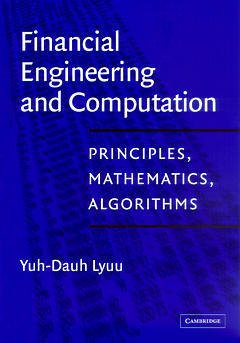Description
Financial Engineering and Computation
Principles, Mathematics, Algorithms
Author: Lyuu Yuh-Dauh
A comprehensive text and reference, first published in 2002, on the theory of financial engineering with numerous algorithms for pricing, risk management, and portfolio management.
Language: English
Subject for Financial Engineering and Computation:
Approximative price 127.44 €
Subject to availability at the publisher.
Add to cart
Publication date: 11-2001
648 p. · 17.8x25.4 cm · Hardback
648 p. · 17.8x25.4 cm · Hardback
Description
/li>Contents
/li>
Students and professionals intending to work in any area of finance must master not only advanced concepts and mathematical models but also learn how to implement these models computationally. This comprehensive text, first published in 2002, combines the theory and mathematics behind financial engineering with an emphasis on computation, in keeping with the way financial engineering is practised in capital markets. Unlike most books on investments, financial engineering, or derivative securities, the book starts from very basic ideas in finance and gradually builds up the theory. It offers a thorough grounding in the subject for MBAs in finance, students of engineering and sciences who are pursuing a career in finance, researchers in computational finance, system analysts, and financial engineers. Along with the theory, the author presents numerous algorithms for pricing, risk management, and portfolio management. The emphasis is on pricing financial and derivative securities: bonds, options, futures, forwards, interest rate derivatives, mortgage-backed securities, bonds with embedded options, and more.
1. Introduction; 2. Analysis of algorithms; 3. Basic financial mathematics; 4. Bond price volatility; 5. Term structure of interest rates; 6. Fundamental statistical concepts; 7. Option basics; 8. Arbitrage in option pricing; 9. Option pricing models; 10. Sensitivity analysis of options; 11. Extensions of options theory; 12. Forwards, futures, futures options, swaps; 13. Stochastic processes and Brownian motion; 14. Continuous-time financial mathematics; 15. Continuous-time pricing; 16. Hedging; 17. Trees; 18. Numerical methods; 19. Matrix computation; 20. Time series and estimation; 21. Interest rate derivative securities; 22. Term structure fitting; 23. Introduction to term structure modeling; 24. Foundations of term structure modeling; 25. Equilibrium term structure models; 26. No-arbitrage term structure models; 27. Fixed-income securities; 28. Introduction to mortgage-backed securities; 29. Analysis of mortgage-backed securities; 30. Collateralized mortgage obligations; 31. Modern portfolio theory; 32. Software.
© 2024 LAVOISIER S.A.S.

